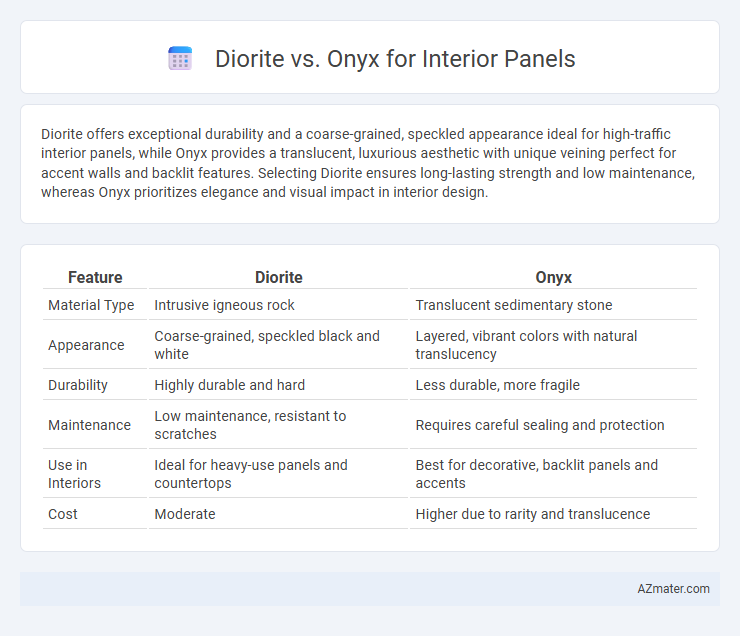Diorite offers exceptional durability and a coarse-grained, speckled appearance ideal for high-traffic interior panels, while Onyx provides a translucent, luxurious aesthetic with unique veining perfect for accent walls and backlit features. Selecting Diorite ensures long-lasting strength and low maintenance, whereas Onyx prioritizes elegance and visual impact in interior design.
Table of Comparison
| Feature | Diorite | Onyx |
|---|---|---|
| Material Type | Intrusive igneous rock | Translucent sedimentary stone |
| Appearance | Coarse-grained, speckled black and white | Layered, vibrant colors with natural translucency |
| Durability | Highly durable and hard | Less durable, more fragile |
| Maintenance | Low maintenance, resistant to scratches | Requires careful sealing and protection |
| Use in Interiors | Ideal for heavy-use panels and countertops | Best for decorative, backlit panels and accents |
| Cost | Moderate | Higher due to rarity and translucence |
Introduction to Diorite and Onyx as Interior Panel Materials
Diorite and onyx are premium natural stones frequently used for interior panels, prized for their distinct aesthetics and durability. Diorite features a coarse-grained texture with a mix of dark and light minerals, offering a robust, speckled appearance ideal for modern and rustic interiors. Onyx is a translucent, banded stone with vibrant colors and unique veining, often backlit to create dramatic, luxurious focal points in upscale interior designs.
Geological Origins and Composition of Diorite and Onyx
Diorite is an intrusive igneous rock primarily composed of plagioclase feldspar, biotite, hornblende, and sometimes quartz, formed from the slow cooling of magma beneath the Earth's surface, resulting in a coarse-grained texture ideal for durable interior panels. Onyx is a banded form of chalcedony, a cryptocrystalline variety of quartz, created through the deposition of silica from groundwater in limestone caves, featuring translucent layers that provide a striking aesthetic for decorative paneling. The contrasting geological origins and mineral compositions of diorite and onyx influence their physical properties and visual appeal in interior design applications.
Aesthetic Differences: Colors, Patterns, and Textures
Diorite showcases a speckled, granular texture with a predominantly light to dark gray palette featuring white and black mineral flecks, offering a natural and subtle elegance ideal for minimalist interiors. Onyx presents a striking variety of vibrant colors, including rich earth tones, amber, and translucent whites, often with dramatic veining and banding that creates a luxurious, eye-catching statement in interior panels. The smooth, polished finish of onyx contrasts with diorite's more rugged, coarse texture, providing distinct aesthetic options depending on the desired ambiance and design emphasis.
Durability and Strength Comparison
Diorite exhibits exceptional hardness and resistance to abrasion, making it highly durable for interior panels subjected to heavy use. Onyx, while visually striking with its translucent properties, is comparatively softer and more prone to scratches and fractures. For applications demanding robust strength and longevity, diorite is preferred over onyx due to its superior structural integrity.
Maintenance Requirements and Longevity
Diorite offers exceptional durability and low maintenance due to its high hardness and resistance to scratches and stains, making it ideal for long-lasting interior panels. Onyx, while visually striking with its translucent and luxurious appearance, requires more careful upkeep because it is softer and more prone to etching and damage from acidic substances. Both materials can enhance interiors, but diorite is preferred for longevity and ease of maintenance in high-traffic areas.
Cost Considerations for Diorite vs. Onyx Panels
Diorite panels generally present a more cost-effective option compared to onyx, with prices varying widely depending on quality and source but typically ranging from $50 to $150 per square foot, while onyx panels often command prices between $100 and $300 per square foot due to their rarity and translucency. Installation costs for both materials are influenced by their weight and fragility; onyx requires specialized handling and lighting integration, which can increase labor expenses. Budget planning for interior paneling should weigh the higher upfront investment in onyx against its aesthetic appeal and luxury status, whereas diorite offers durability and affordability without compromising on elegance.
Installation Process and Challenges
Diorite panels require precise cutting due to their high hardness, often necessitating diamond-tipped tools to ensure clean edges and reduce the risk of fractures during installation. Onyx, being a softer and more brittle material, demands careful handling and backing reinforcement to prevent cracking and support its translucency when installed as interior panels. Both materials present challenges in alignment and securing, with Diorite's weight requiring strong anchors and Onyx needing specialized adhesives to maintain its structural integrity and aesthetic appeal.
Design Versatility and Application Areas
Diorite offers a coarse-grained texture and durability, making it ideal for high-traffic interior panels in commercial spaces and modern residential designs. Onyx, with its translucent properties and unique veining, excels in feature walls, backlit panels, and luxurious settings where dramatic aesthetics are a priority. Both materials provide distinct design versatility, with diorite suited for robust, sleek surfaces and onyx favored for artistic, statement applications.
Environmental Impact and Sustainability
Diorite, a durable igneous rock, offers a lower environmental impact due to its abundant availability and minimal processing requirements compared to Onyx, which is a more delicate and often imported stone with higher extraction and transportation emissions. Onyx, while visually striking, generally requires more intensive quarrying and chemical treatments that increase its carbon footprint and reduce sustainability. Choosing Diorite for interior panels supports eco-friendly building practices by minimizing resource depletion and promoting long-lasting material use.
Choosing the Right Stone: Diorite or Onyx for Your Space
Diorite offers exceptional durability and a speckled, granular appearance ideal for high-traffic interior panels, while Onyx provides a translucent, luxurious look that enhances ambient lighting with its natural backlit effect. Selecting between Diorite and Onyx depends on balancing the need for strength and maintenance with aesthetic impact and light diffusion. For spaces requiring robust performance, Diorite is the optimal choice, whereas Onyx suits areas aiming for dramatic visual appeal and elegant ambiance.

Infographic: Diorite vs Onyx for Interior Panel
 azmater.com
azmater.com